This is a guest post by Nico Prins. Nico is an online marketer and the founder of Launch Space. He helps companies make money blogging. He’s worked with everyone from Fortune 500 companies to startups helping them develop content marketing strategies that align with their business goals.
The problem with SaaS is getting people to see the value in your product. This is difficult, especially if your product is complex. Moreover, in every niche, you will have dozens of competitors with a similar product offering, often at a lower price point.
Some companies have found a curious way to overcome this challenge — by offering high-end courses.
In this guide, I’ll cover why one of the biggest problems impacting the growth of your SaaS company is churn. I’ll then show you why a high-end course could be your solution and provide some real-world examples of companies that are having great success with this method (including one company that scaled to millions of dollars in Annual Recurring Revenue in just a few short years).
The Link Between Usage and Lifetime Value
Usage, or consumption, measures the engagement of customers with your product. As a general rule of thumb, the higher the rate of consumption the more value they are seeing from your service. The most engaged users are the ones who are most likely to stay with you for the long term. Or to rephrase that using business lingo… There is a clear correlation between the rate of consumption and customer LTV.
Below is a nice example of the kind of correlation companies tend to see when they get an engaged user.
You can see a graph from a study by Harvard Business Review that has some interesting stats on how consumption impacts LTV. The data is based on analysis of membership trends for a gym/country club in the US.
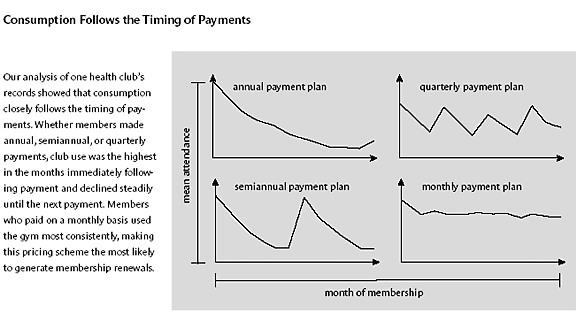
The graph shows how payment plans impact usage. In the example above, you can see there is a correlation between how much people use a service and their willingness to pay for it. If a customer doesn’t see value in the product or service they won’t pay.
Low rates of consumption are less of a problem for a company selling a product, but for a SaaS company that needs to “sell” a renewal every month low consumption rates result in high churn.
If you can reduce your churn you can scale your company faster.
All of this data highlights the point that if you want to keep the people who sign up for your SaaS product, they need to receive a benefit or they will question why they are paying you.
Why Are Courses a Good Way to Scale Your SaaS Company
There are many methods for reducing churn, but fundamentally every strategy boils down to ensuring that the benefits a customer receives outweigh the cost of the service you are offering.
A course is a useful tool for growing your company when knowledge is an important element in your customers’ success. Let me give you a couple of hypothetical examples to make my point:
- If a customer finds it easier to use your blogger outreach software to generate guest post opportunities than they would without it, then the software is useful
- When a customer can use your email marketing software to make more money, they are happy
- If a customer finds it easier to use your Facebook Ads software to run their PPC campaigns, you are onto a winner
In all of the examples listed above, your software is just a tool for achieving a business goal. For example, to get the most use of email marketing software you need to:
- Have an email list or be able to grow one
- Understand the basics of email marketing and email sequences
- Know how to write a sales email
Without this knowledge, you won’t make the best use of the software. If you aren’t using the tool or seeing a positive result, there is a higher chance you will stop using it. A course can help fill in these knowledge gaps for your customers.
Of course, you should only provide a course to your customers when the goals of your business align with those of the customer. There is little value in you offering a course about how to code if you are running a graphic design platform. While you might find people who are willing to buy the course, the knowledge they get won’t help them use your tool.
Should You Charge For Your Course
So now we get onto the issue of pricing. The title of this guide is “How to Use High-End Courses to Grow Your SaaS Company.” In this instance high-end means expensive.
In this article, I look at three examples of companies that have used courses costing $500 or more to grow their SaaS business. There are a couple of reasons you might want to sell a course to grow your SaaS company:
- Revenue: Selling a course generates revenue that you can reinvest into the business;
- Motivation: People who pay for a course supposedly get more value from it and are more likely to complete it;
- Self-Selection: The people who buy a course have the budget and desire to succeed. You can segment these customers and offer them additional support.
The first statement is obviously true. Online courses are a huge (and growing) industry.
In regards to the second statement, there is no clear correlation between the price of an online course and the completion rate.
Course creators love to use it to justify why customers should spend a lot of money on their course, but the completion rate of a course depends above all on the quality of the content.
There is a case for providing a free course to your customers. The obvious benefit is that everyone will get access to it. You can also use the free course as an enticement for signing up to your platform, or as part of the customer onboarding process.
Let’s look at some real-life business development strategies from companies using high-end courses to acquire and retain customers.
Market Hero
If you want an absolute masterclass in how to grow a SaaS company with high-end courses, you need look no further than Market Hero. The company has created an email automation program designed for people running a Shopify store. In a saturated niche, Market Hero laser-focused on their target audience.
When this email automation platform launched a few years ago, you could have been forgiven for thinking that the market was already sewn up by major low-cost players like MailChimp, as many mimicked their successful “forever free” pricing and there are now plenty of email software tools. Within a few short years, Alex Becker grew the company into a multi-million dollar enterprise.
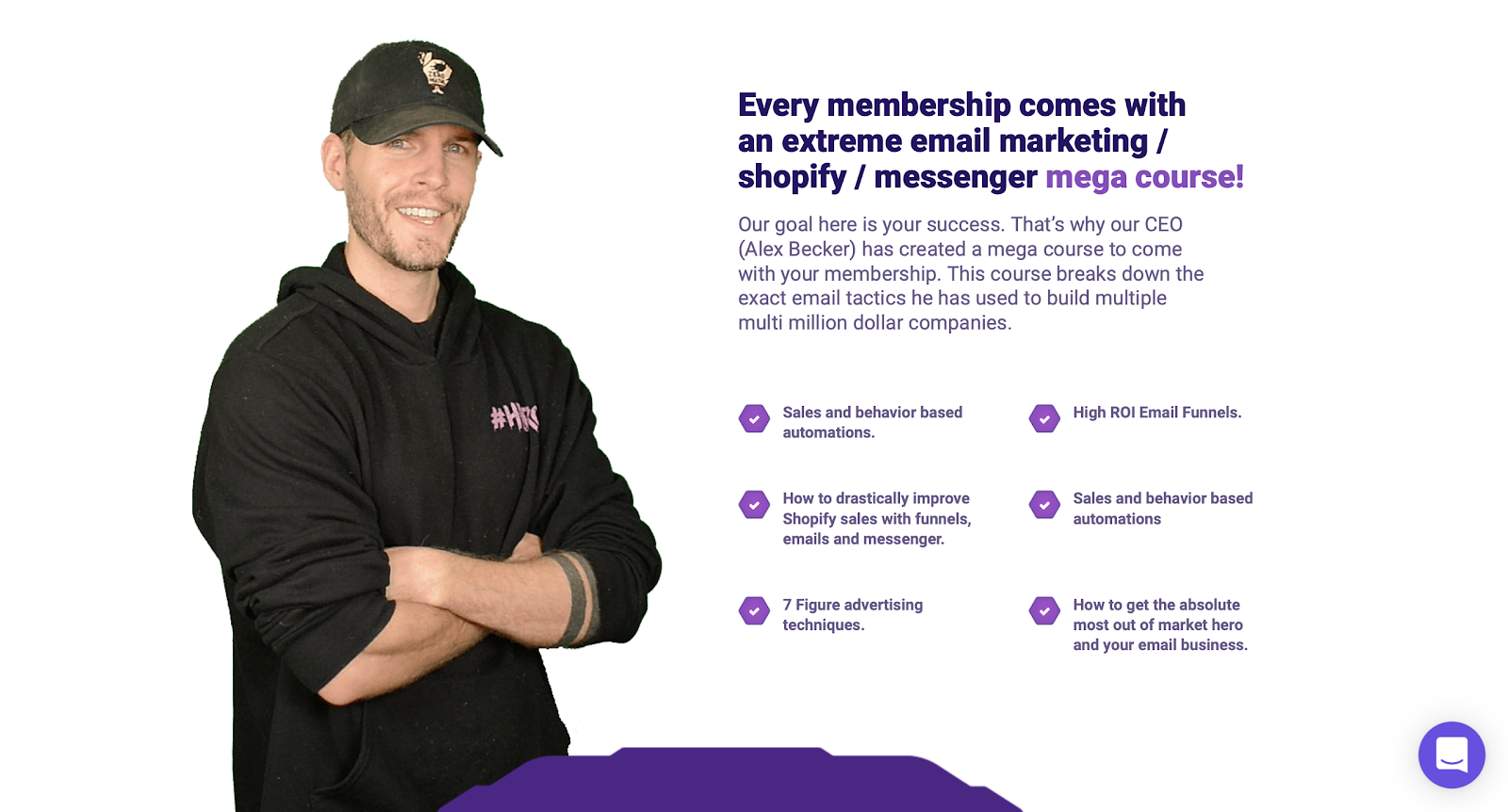
So how did Market Hero scale so quickly?
A large part of their success can be attributed to an innovative customer acquisition funnel based on selling an expensive e-commerce course. The course is priced at around $2,000. This fluctuates based on testing. Wrapped up in the course, which provides the theory for creating a successful e-commerce store, is a 3-month license to Market Hero.
Below is a quick overview of what the acquisition funnel looks like:

The funnel starts with Youtube Ads that target people who are likely to purchase the course. They are then sent to the webinar signup page. You can access the page here.
When you sign up you are sent a confirmation email. You will be sent to a webinar where Alex Becker will try to sell you his e-commerce course. If you don’t purchase the course then you are sent a series of follow up emails.
The sales funnel Market Hero use has been carefully optimized over the years. They cover the cost of the ad spend from people who sign up for the course.
This also serves as a lead generation campaign. For each person that signs up, they get hundreds of people who don’t, who are still potential Market Hero customers. For example:
- You advertise to 100,000 people with a FB ad
- 1,000 people sign up to the webinar and provide their email address
- 10 people buy the course

The 990 people who didn’t buy the course are then targeted through email marketing, webinars, and other marketing channels to get them to sign up to Market Hero. It’s a system that enabled Market Hero to rapidly scale their user base.
Introductory webinars are a great way to captivate and entertain your potential customers while building the trust needed to take the next step in the funnel. It allows you to warm them up for a longer commitment and take the high-end course. The registration for a webinar also allows you to collect emails and drive more webinar attendance through email.
The reason this works so well is that each stage of this funnel is aimed at building up the capacity of people who want to start an e-commerce company. This capacity building is logically tied in with the SaaS product offering.
In addition to using high-end courses as a customer acquisition strategy, Market Hero also give anyone that signs up to the platform access to courses. They understand the importance of consumption.
Youzign
Youzign is a one-stop-shop visual marketing platform for non-design geeks. They are operating in a competitive niche where the market leader Canva runs a freemium platform.
To stand out in this vertical, Youzign offers a course titled Visual Story Mastery. Many of Youzign’s users are not design specialists. For this reason, most users need two types of capacity building:
- Develop an understanding of the business applications of the platform
- Learn some of the fundamentals of good design
In addition to increasing consumption, students learn how to make their Youzign creations more effective in terms of their own business goals. This helps the product pay for itself.
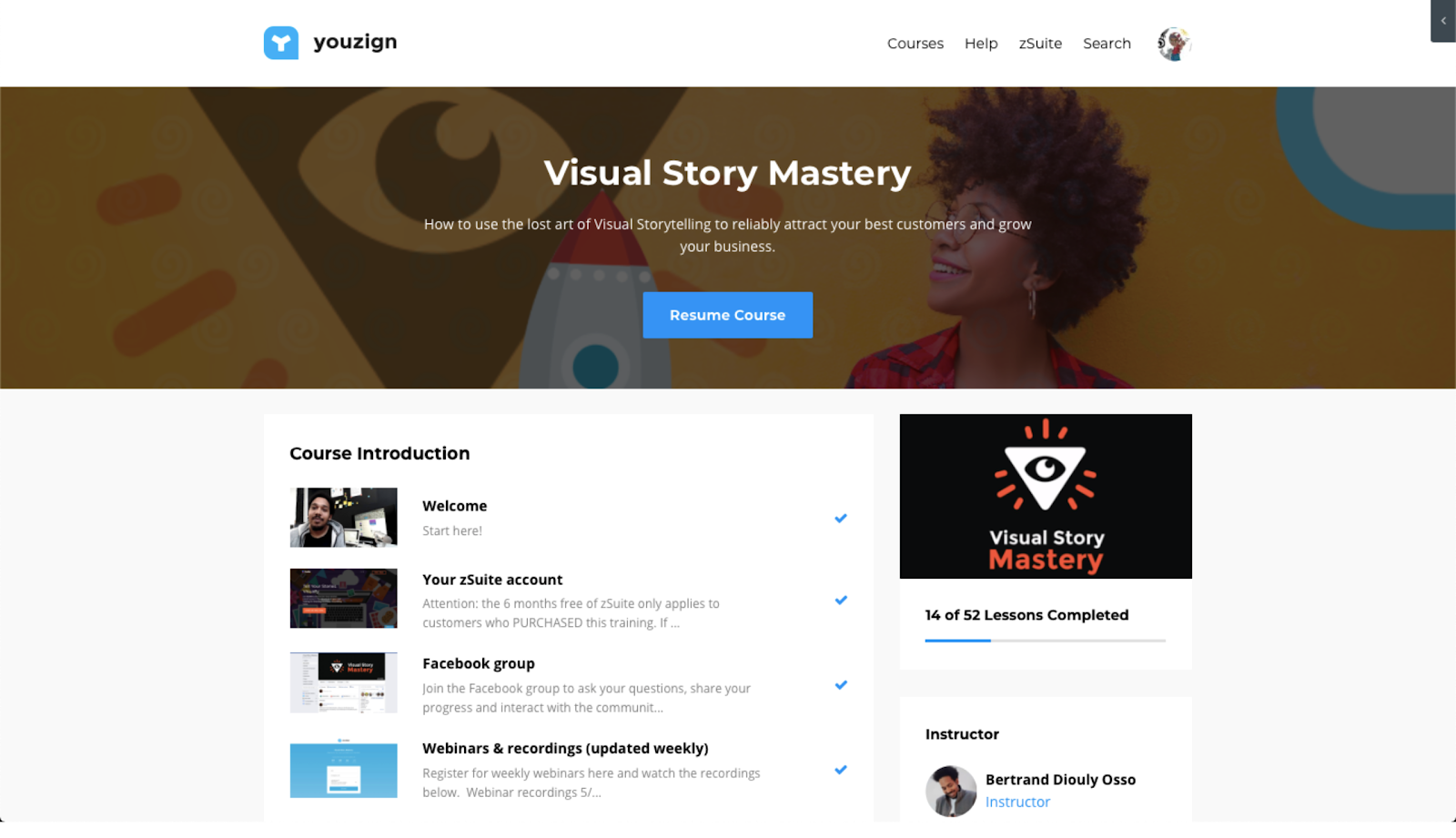
The third thing to consider within the context of Youzign is the value of the course as a means of generating a connection with students. Students who complete Visual Story Mastery spend hours listening to the founder talk at length about business and design. This is further reinforced through membership of an active Facebook group.
As any psychologist would remind you, emotions shouldn’t be overlooked. Humans like to feel that they belong, which is why most people identify with a group or a set of beliefs. A course can form the introduction to such a group.
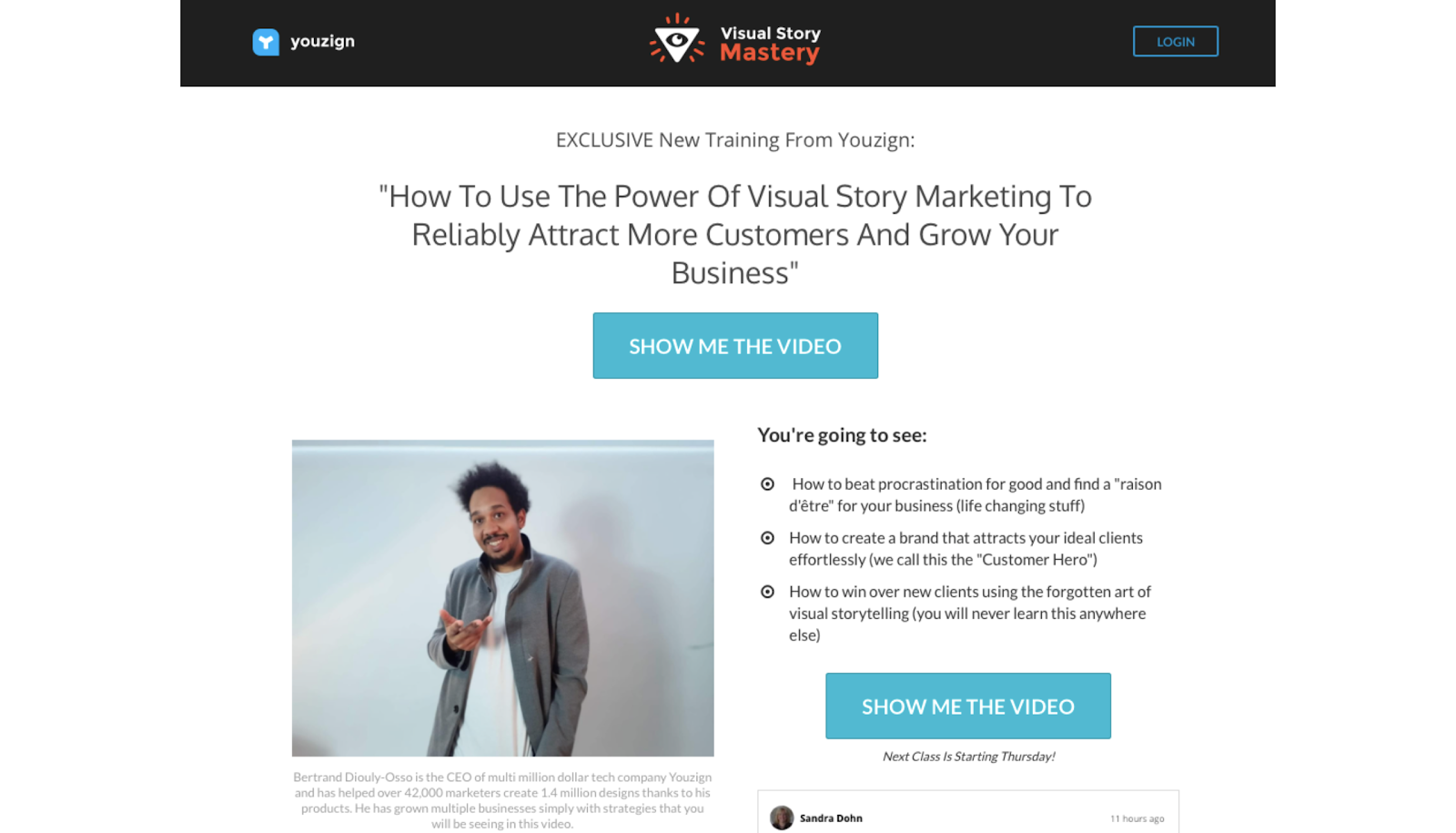
The course is closely tied to the product offering. People who purchase the course get access to a free 6-month subscription to the product itself. This is crucial.
In the bootstrapped startup economy, high-end courses allows SaaS to acquire paid subscribers at no cost. This formula has worked for companies like Clickfunnels and its CEO Russel Brunson, allowing them to gross over $100 million in just a couple of years without any outside investment. We are applying the same strategy to grow our user base over here atYouzign.
Bertrand, Founder of Youzign
Youzign understands that increased consumption of their course goes hand in hand with increased consumption of their product. And it’s all about maximizing user capacity.
Vyper
Vyper is an online software platform that enables customers to run online competitions. They have used expensive courses to grow their customer base. They offer several courses that aim to improve the capacity of their users to successfully utilize their platform.
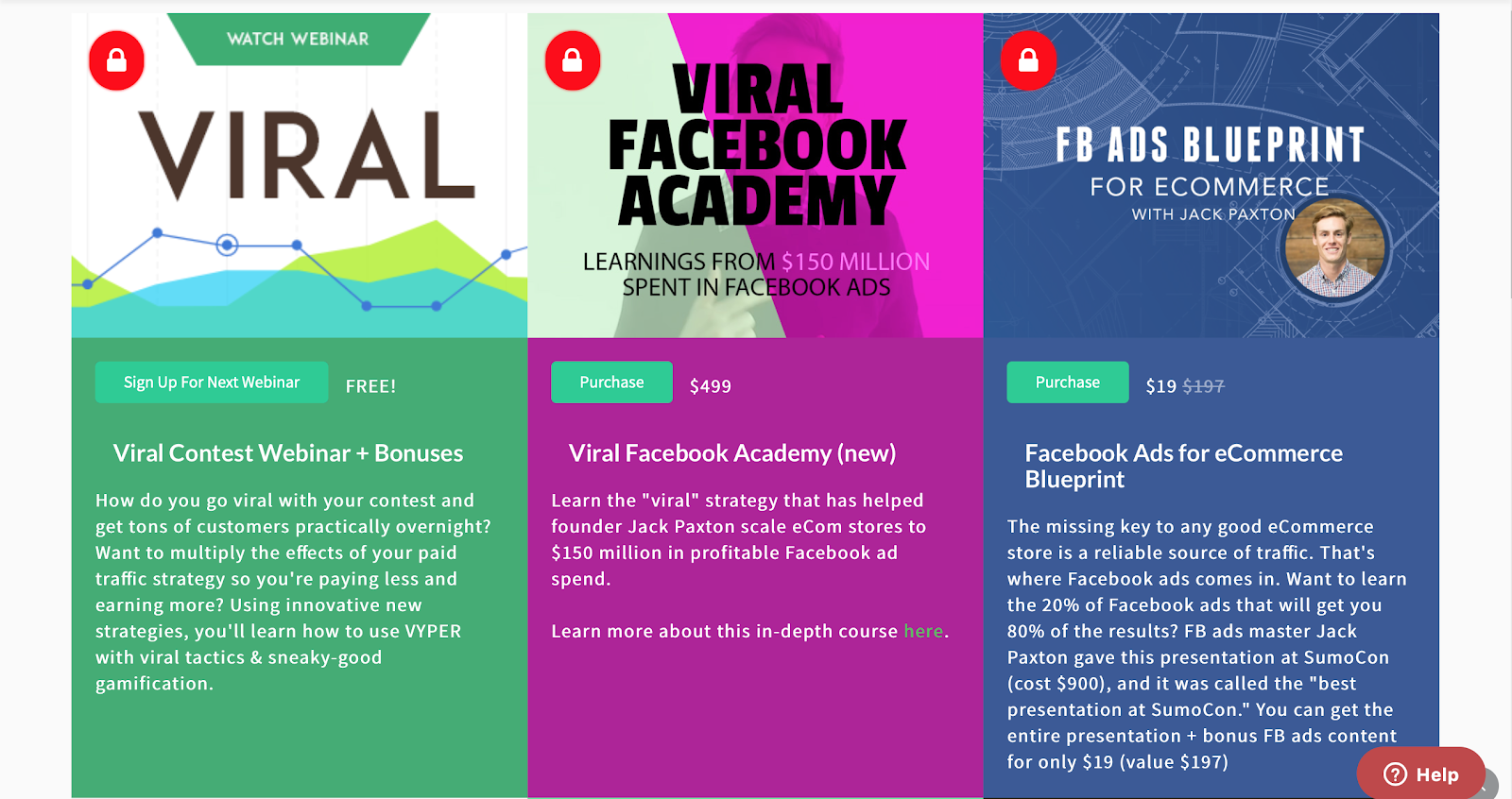
One of the co-founders of the company, Jack Paxton, conducted interviews with customers to identify their pain points. Based on responses they found that there is a correlation between the ability to run a successful Facebook advertising campaign and the chance of a competition being successful.
As a result of this customer research, they decided to create three courses. According to Jack, the aim of the courses is two-fold:
- To provide users with the underlying skills they needed to run effective competitions
- To establish expertise and credibility with users
The Viral Facebook Academy, the most expensive course, is aimed at customers who have the budget to scale and become super users. The course covers everything about Facebook advertising, from copywriting through to targeting. There isn’t even a mention of how to run a competition using Facebook until the 15th and final installment.
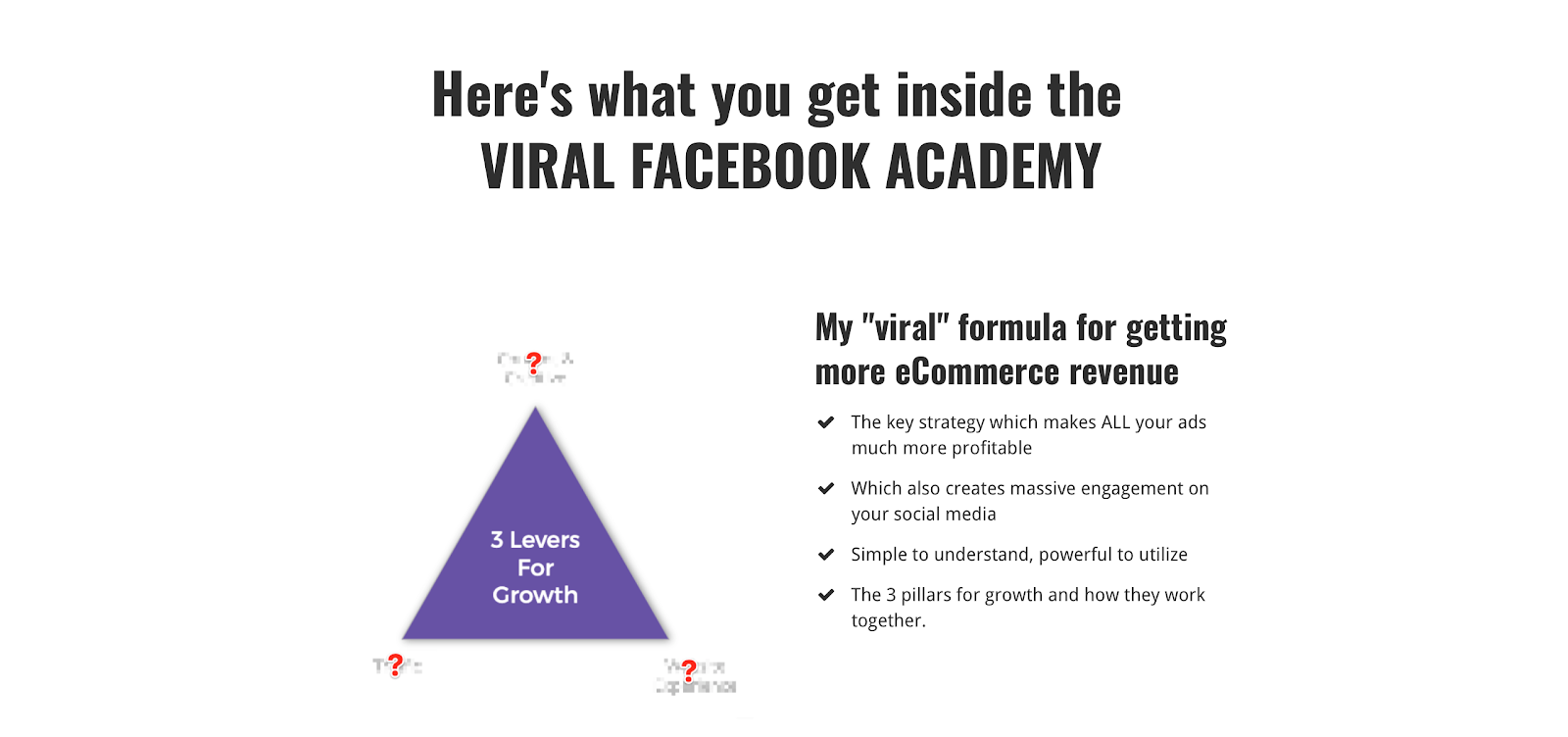
Unlike the other two examples, Vyper’s flagship Facebook Academy course comes with a free lifetime license of the Pro version of their platform. A quick look at their product range says a lot about why they do this.

You’ll notice that the Pro license is limited both in terms of the number of competition participants it allows, and the total amount of trackable revenue. The ultimate aim of the course and license giveaway is to maximize consumption to the point that users are ready to move on to purchasing the Enterprise and Agency Licenses. This is their ideal customer target demographic.
How You Can Use Courses To Grow Your SaaS
High-end courses are a powerful method for both acquiring new customers, and keeping the ones that you have. Creating sellable courses that help your students achieve specific results that are closely tied to your product offering can increase consumption.
Additionally, creating valuable courses to drip-feed insights to your existing customers improves your retention, by ensuring that they can use the product to the fullest. In both cases, the aim remains the same — getting people to stick with your product.
